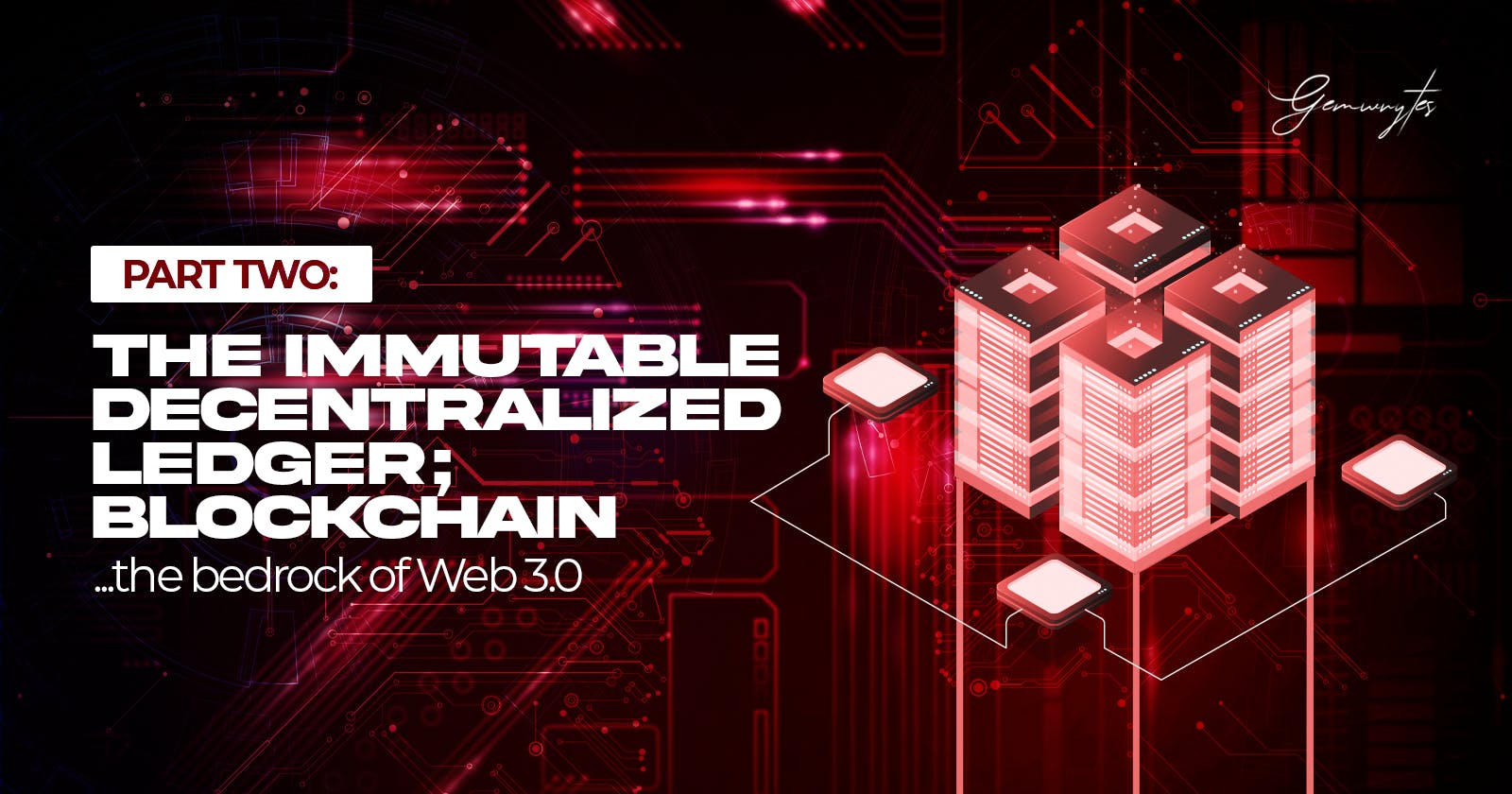THE IMMUTABLE DECENTRALIZED LEDGER; BLOCKCHAIN...the bedrock of Web 3.0
Part 2: Understanding technical underpinnings of Web 3.0...
a system in which a record of transactions, especially those made in a cryptocurrency, is maintained across computers that are linked in a peer-to-peer network. ~Google
OVERVIEW AND INTRODUCTION
Blockchain technology has been one of the most transformative inventions of the past decade. It has revolutionized the way we store, transfer, and access data. Blockchain is the underlying technology behind digital currencies like Bitcoin and Ethereum, and it has now expanded to other industries such as supply chain, healthcare, and logistics.
Web 3.0 utilizes Blockchain technology to eliminate centralization and inculcate decentralization. This satisfies the desire to transfer power from central authorities to normal individuals. It is therefore safe to say that the Blockchain is the bedrock of Web 3.0...
In this article, we will delve into the concept of Blockchain (working principles), its various layers, and how they contribute to the development of the Web 3.0 ecosystem.
WHAT IS A BLOCKCHAIN?
A blockchain is a system of interconnected computers -distributed digital ledger- that records transactions securely and transparently. It is essentially a database that stores information across a network of computers, rather than on a single centralized server. The information on the blockchain is organized into blocks, which are linked together in a chain, hence the name "Blockchain".
The key feature of the blockchain is its decentralized nature. There is no central authority that controls the blockchain. Instead, the network of computers that make up the blockchain works together to maintain and validate the data on the blockchain. This means that the blockchain is highly resistant to censorship and hacking, making it one of the most secure technologies in the world.
WORKING PRINCIPLES OF THE BLOCKCHAIN
A blockchain is a distributed database that is spread across a network of computers. Each computer on the network has a copy of the blockchain, which is updated every time a new block is added. When a new transaction is made, it is verified by a network of computers using complex algorithms. Once the transaction is verified, it is added to a block, which is then added to the chain.
Each block in the chain contains:
• a unique code called a cryptographic hash, which is generated by the previous block's hash,
• a timestamp, and
• The transaction data.
This ensures that each block in the chain is connected to the previous one and cannot be altered or deleted without disrupting the entire chain's integrity.
Blockchain technology uses a consensus mechanism to verify transactions. In the case of Bitcoin, the consensus mechanism is called proof-of-work, where miners compete to solve complex mathematical puzzles to add new blocks to the chain. Once a block is added, it cannot be altered, making the blockchain immutable.
LAYERS OF THE BLOCKCHAIN
The Blockchain comprises distinct layers consisting of various functions and infrastructures that come together to establish a decentralized, transparent, and secure system. This could be referred to as a layered architecture which gives a unique way of authenticating transactions. In this layered architecture, there are five layers involved. They include:
The Infrastructure Layer: To create a decentralized system using Blockchain, people transfer information (like money or data) directly to each other using their computers. The infrastructure layer is made up of many devices that communicate with each other to transmit this information.
The Information (Data) Layer: The data layer in the Blockchain comprises information (value) stored in blocks, which are linked to the previous block after being added to the Blockchain. Every Blockchain has a pioneer block, known as the Genesis block, which is not connected to any prior block. Subsequent blocks are added to the Genesis block. The process of adding blocks is repeated to form a chain of blocks.
The Network Layer: Computing systems work together to record and store data in blocks that are added to the Blockchain. Before adding a block, nodes must reach a consensus on its validation. Every node in the Blockchain should have a copy of the information record of the entire Blockchain and be able to discover other nodes for fast communication. The network layer comprises individual nodes that work together for inter-node communication.
The Consensus (Agreement) Layer: The Consensus layer validates transactions and is essential for the Blockchain system to work. It requires multiple nodes to agree on the validity of each transaction, which maintains the system's decentralized nature and prevents any one node from having complete control of the data.
The Application layer: The application layer is where smart contracts and decentralized applications (DApps) operate. Smart contracts make decisions based on commands such as achievements, prices, and expiration dates, and DApps execute the actions that follow. DApps also facilitate communication between user devices and the Blockchain.
APPLICATIONS OF THE BLOCKCHAIN
Blockchain technology has the potential to transform several industries by providing secure, transparent, and decentralized systems. Here are some of the potential applications of blockchain:
• Cryptocurrencies: Cryptocurrencies like Bitcoin and Ethereum use blockchain technology to enable secure and transparent transactions without the need for intermediaries like banks. The blockchain ensures that each transaction is verified and recorded, making it difficult to manipulate the system.
• Supply Chain Management: Blockchain technology can be used to create secure and transparent supply chain systems. Each step in the supply chain can be recorded on the blockchain, providing a transparent and tamper-proof record of the product's journey from the manufacturer to the consumer.
• Digital Identity Management: Blockchain technology can be used to create secure and decentralized digital identity systems. Each user's identity can be verified and stored on the blockchain, providing a secure record of their identity.
• Voting Systems: Blockchain technology can be used to create secure and transparent voting systems. Each vote can be recorded on the blockchain. This offers a transparent record of the election results, making it difficult to manipulate the system.
• Healthcare Records: Blockchain technology can be used to create secure and decentralized healthcare record systems. Each patient's medical record can be verified and stored on the blockchain. This secures the record of their medical history.
• Smart Contracts: Smart contracts are self-executing contracts with the terms of the agreement between buyer and seller being directly written into lines of code. Smart contracts use blockchain technology to enable secure and transparent transactions without the need for intermediaries.
BENEFITS OF THE BLOCKCHAIN
Blockchain technology provides several benefits over traditional systems, including:
• Security: The Blockchain utilizes advanced cryptography and consensus mechanisms to ensure that each transaction is secure and cannot be tampered with. Once a transaction is added to the blockchain, it cannot be altered, making the blockchain immutable.
• Transparency: Blockchain technology provides a transparent and clear record of transactions. Each transaction is recorded on the blockchain, providing an accurate record of the transaction.
• Decentralization: Blockchain technology is decentralized, meaning that there is no central authority controlling the system. Each node on the network has a copy of the blockchain, making it difficult to hack or manipulate the system.
• Efficiency: Blockchain technology enables faster and more efficient transactions. Because there are no intermediaries involved, transactions can be processed faster, and the need for manual verification is eliminated, reducing the chances of errors or delays.
• Cost-effectiveness: Blockchain technology can significantly reduce costs by eliminating the need for intermediaries like banks or lawyers. Transactions can be processed directly between the parties involved, reducing transaction fees and other related costs.
CHALLENGES FACED
While blockchain technology provides several benefits, some challenges need to be addressed, these challenges are:
• Scalability: The blockchain can become slow and inefficient as the number of transactions increases. To address this challenge, developers are exploring new consensus mechanisms like proof-of-stake and sharding.
• Regulatory Issues: The regulatory framework for blockchain technology is still evolving, which can create uncertainty for businesses and investors. Regulators are working to establish guidelines to ensure that blockchain technology is used responsibly and does not facilitate illegal activities.
• Interoperability: The lack of interoperability between different blockchain networks can create challenges for businesses that want to use multiple blockchain networks. Developers are working to create standard protocols that will enable interoperability between different blockchain networks.
FINAL NOTE
Blockchain technology has the potential to transform several industries by providing secure, transparent, and decentralized systems. The blockchain ensures that each transaction is verified and recorded, making it difficult to manipulate the system. Blockchain technology can be used in several applications, including cryptocurrencies, supply chain management, digital identity management, voting systems, healthcare records, and smart contracts. While blockchain technology provides several benefits, some challenges need to be addressed, including scalability, regulatory issues, and interoperability.
Web 3.0 utilizes the diverse functions of the Blockchain to create a decentralized society. This has been able to transform the way we do business, govern, and interact with one another.

